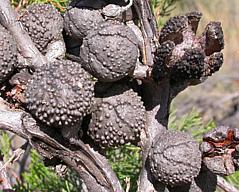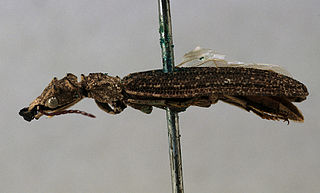
Southwest Australia is a biogeographic region in Western Australia. It includes the Mediterranean-climate area of southwestern Australia, which is home to a diverse and distinctive flora and fauna.

Mitchell's hopping mouse also known as the pankot, is the largest extant member of the genus Notomys, weighing between 40 and 60 g. N. mitchellii is a bipedal rodent with large back legs, similar to a jerboa or kangaroo rat. The species occurs throughout much of semi-arid Southern Australia, and appears to be particularly common on the Eyre Peninsula, South Australia. Typical habitat for N. mitchellii appears to be mallee shrublands on sandy dune systems. The species is currently considered to be unthreatened, but its range has been reduced through habitat disturbance and destruction associated with European settlement in Australia.

The red-lored whistler is one of nine species of whistler occurring in Australia and a member of the family Pachycephalidae which includes whistlers, shrike-thrushes, pitohuis and allies. The limited range of this endemic bird of the Mallee woodland in one small area in New South Wales and another, larger area encompassing north-western Victoria and adjacent South Australia has seen it listed nationally as vulnerable.

Mallee are trees or shrubs, mainly certain species of eucalypts, which grow with multiple stems springing from an underground lignotuber, usually to a height of no more than 10 m (33 ft). The term is widely used for trees with this growth habit across southern Australia, in the states of Western Australia, South Australia, New South Wales and Victoria, and has given rise to other uses of the term, including the ecosystems where such trees predominate, specific geographic areas within some of the states and as part of various species' names.

Bolam's mouse is a species of nocturnal, burrowing rodent in the family Muridae that inhabits the semi arid and southern arid regions of Australia. It has a number of physiological and behavioural adaptations developed to cope with an extremely varied climate. Including the ability survive by extracting water from seeds alone, the production of highly concentrated urine, low water content faeces and nocturnal activity.

Callitris verrucosa, also known as the mallee pine, is a species of conifer in the family Cupressaceae. It is found only in Australia. The plant has a green/grey colour, rigid branches and can reach a height of 8 metres (26 ft). It has a slow grow rate.

The mangrove honeyeater is a species of bird in the honeyeater family Meliphagidae. The species was once considered to be conspecific with the varied honeyeater, but it is now treated as a separate species. These two species form a genus with the singing honeyeater.

Eucalyptus oleosa, commonly known as the red mallee, glossy-leaved red mallee, acorn mallee, oil mallee or giant mallee, is a tree or mallee that is native to Australia. The leaves were once harvested for the production of cineole based eucalyptus oil. Eucalyptus cneorifolia is now the predominant strain used in production due to a higher oil content in new growth.

Mallee Woodlands and Shrublands is one of 32 Major Vegetation Groups defined by the Australian Government Department of the Environment and Energy and one of the 189 habitats in the HOTW habitats of the World classification.

The Ommatidae are a family of beetles in the suborder Archostemata. The Ommatidae are considered the extant beetle family that has most ancestral characteristics. There are only seven extant species, confined to Australia and South America. However, the geographical distribution was much wider during the Mesozoic spanning across Eurasia and Australia, suggesting that they were widespread on Pangea. So far, over 26 extinct genera containing over 170 species of these beetles have been described. Three extant genera have been assigned to this family: Omma,Tetraphalerus and Beutelius. The family is considered to be a subfamily of Cupedidae by some authors, but have been found to be more closely related to Micromalthidae in molecular phylogenies. A close relationship with Micromalthidae is supported by several morphological characters, including those of the mandibles and male genitalia. Due to their rarity, their ecology is obscure, it is likely that their larvae feed on deadwood.

The Coolgardie woodlands is an ecoregion in southern Western Australia. The predominant vegetation is woodlands and mallee scrub. The ecoregion is a transitional zone between the Mediterranean-climate forests, woodlands, and shrublands of Southwest Australia and the deserts and dry scrublands of the Australian interior.

Acacia lineataA.Cunn. ex G.Don, commonly known as streaked wattle or narrow lined-leaved wattle, occurs naturally inland eastern Australia. The genus Acacia is the largest genus of flowering plants in Australia, containing around 1000 species throughout a diverse range of environments from coast to desert.

The Central NSW Mallee Important Bird Area is an irregularly shaped 2500 km2 tract of land in western New South Wales, Australia. It lies near the small town of Mount Hope and comprises the nature reserves of Yathong, Nombinnie and Round Hill, with some unreserved crown land, containing remnant mallee woodland and shrubland habitat. It was identified and classified as an Important Bird Area (IBA) because it supports isolated key populations of the malleefowl and the red-lored whistler. It is also at the centre of distribution in New South Wales for other mallee bird species, including the shy heathwren, striated grasswren, southern scrub-robin and chestnut quail-thrush.

Eucalyptus langleyi, commonly known as the green mallee ash or albatross mallee, is a species of mallee that is endemic to a small area of New South Wales. It has mostly smooth grey to yellowish bark, lance-shaped to curved adult leaves, flower buds in groups of seven, white flowers and cup-shaped to barrel-shaped fruit.

Omma is a genus of beetles in the family Ommatidae. Omma is an example of a living fossil. The oldest species known, O. liassicum, lived during the final stage of the Triassic (Rhaetian), over 200 million years ago, though the placement of this species in Omma has been questioned. Numerous other fossil species are known from the Jurassic and Cretaceous of Europe and Asia. The only living species is Omma stanleyi, which is endemic to Australia. Three other extant species endemic to Australia that were formerly part of this genus were moved to the separate genus Beutelius in 2020.Omma stanleyi is strongly associated with wood, being found under Eucalyptus bark and exhibiting thanatosis when disturbed. Its larval stage and many other life details are unknown due to its rarity. Males are typically 14–20 mm in length, while females are 14.4-27.5 mm. Omma stanleyi occurs throughout eastern Australia from Victoria to Central Queensland.

The Charcoal Tank Nature Reserve is a protected nature reserve in the central western region of New South Wales, Australia. The 86.4-hectare (213-acre) reserve is situated 10 kilometres (6.2 mi) south of West Wyalong and may be accessed via the Newell Highway and The Charcoal Tank Road. The reserve is an important refuge for native flora and fauna in a highly fragmented landscape, one in which the majority of the original vegetation has been removed.

The Delma australis is often known as the southern legless lizard, or the marble-faced delma. This terrestrial lizard falls into the category of slender Pygopodidae, a legless lizard. There are 21 known species in the Pygopdidae family in Australia. Marble-faced delmas are endemic to Australia. Delma australis was first described by Kluge in 1974.

Mulga is a type of habitat composed of woodland or open forest dominated by the mulga tree, Acacia aneura, or similar species of Acacia.

The Mallee black-backed snake also known as the Mitchell's short-tailed snake or more commonly as the black-backed snake, is a species of venomous snake from the family Elapidae. This species is native to Australia and is found in a variety of habitats in southern mainland Australia.

Maireana erioclada, commonly known as the rosy bluebush, is a common shrub endemic to Australia, belonging to the genus Maireana.





















